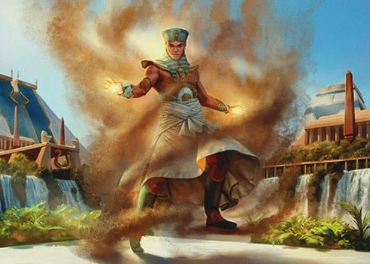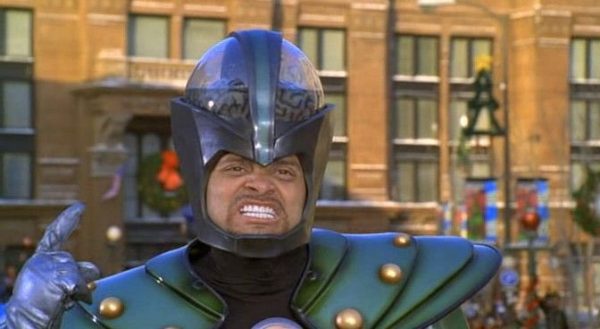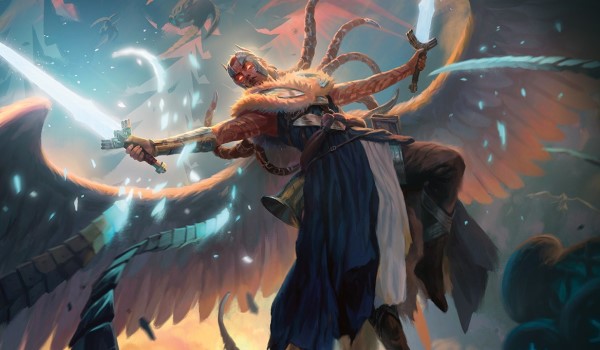Are you a Quiet Speculation member?
If not, now is a perfect time to join up! Our powerful tools, breaking-news analysis, and exclusive Discord channel will make sure you stay up to date and ahead of the curve.
As Draft formats go, March of the Machine (MOM) is considered by some to be the GOAT. Despite being labeled a Prince Format, it offers depth and gameplay. Initially, this format was defined by its bombs, but evolved into a complex and deep environment with plenty of niche decks and new archetypes that seemed to emerge on a weekly basis.
Because of the Multiverse Legend and Battle slots, each pack was loaded with power. The fears about power levels, however, eventually dissipated. With so many build-arounds, drafters tinkered to their heart's content.
This week, we'll put a bow on our MOM coverage in traditional manner, and review the format with rankings and awards.
Archetype Power Rankings
- UB Value - The format's most potent combination held a smorgasbord of value plays. The blue commons are exceptionally deep. Both Halo Forager and Invasion of Amonkhet // Lazotep Convert play like rares. Card draw and removal is a timeless combination, but it gets a leg-up in a slower format dominated by additional rares and uncommons from the Battle and Multiverse Legends slots in each pack. When games go long, players amass lands and find their bombs.
- UW Tempo - While UW Knights was probably the best version of this deck, Hopper Aggro was also a force to be reckoned with. These decks leveraged aggressive starts and discounts on convoke cards to out-tempo the slower, multi-colored decks in the format.
- RB Sacrifice - MOM offered one of the most interesting versions of this archetype in recent memory. It certainly could play a more aggressive gameplan, but it also lent itself well to a slower, more value-oriented approach. This made drafting the deck a more nuanced experience, but also provided options like splashing a third color off of treasure, or even just leaning into powerful three-color options.
- Blighted Burgeoning Green - The impact of extra rares and softened aggro was felt most prominently in the success of this archetype. This format offered a cycle of common dual lands, land cyclers, and both green and colorless fixing. If we are able to collect those pieces and enough powerful payoffs to make it worthwhile, then this deck had the potential to drag opponents through the mud.
- GW and RW Aggro - Both of these decks were dependent on their signpost uncommons, but when able to get multiple copies of Botanical Brawler or Mirror-Shield Hoplite, their power was insurmountable. GW had a little more depth in the form of uncommon payoffs, while RW leveraged aggression better.
- Brews - This format provided opportunities to brew. Whether combining Raff, Weatherlight Stalwart and Tiller of Flesh to grind out opponents with removal or pairing backup creatures and Trailblazing Historian with Horobi, Death's Wail, players could approach the format with creativity. While these decks didn't come together often, they were plenty powerful.
- Abzan Phyrexians - The Abzan colors had powerful cards, but struggled to generate potent engines. Still, with strong one-for-one removal and the right threats, these decks could get there.
Color Rankings
- Blue - Blue felt similar to red in Phyrexia: All Will Be One (ONE). It wasn't as aggressive, but it was just as deep. Any deck that was mostly comprised of blue cards was fine. Blue's flexibility was a defining characteristic. It played an aggressive tempo-based game, as well as being a dominant card advantage color.
- Black - Removal, removal, removal. This color answered the rares in the format better than any other. Deadly Derision and Final Flourish were two of the formats best answers. Unseal the Necropolis provided a great way to grind out games.
- White - There's a steep drop off after black. I have white ranked slightly higher than green on personal preference. It was the most aggressive color, and cards like Aerial Boost and Bola Slinger proved easy-to-get, potent role players in aggressive strategies.
- Green - My least favorite color in the format still deserves some credit for being the best splash enabler.
- Red - There was a lot of play to red in this format. Volcanic Spite is universally strong, but many of the commons shift in value in different archetypes. Ral's Reinforcements can range from excellent role-player to sub-par two drop in the wrong deck. Beamtown Beatstick and Wrenn's Resolve have a similar tension to them. Either way, red had some cards that truly did flop. Thrashing Frontliner, Searing Barb, and Pyretic Prankster // Glistening Goremonger in particular did not live up to expectations.
The Uncommon Common
This was the most obvious recipient since we debuted this series. We identified it in our preview guide, and while I briefly considered an alternative, my error was short-lived.
Preening Champion is a silly card. We start off with a Wind Drake, throw in a 1/1 that can actually fix our mana through convoke, and slot it into the most supported creature type: Knights. Because of cards like Artistic Refusal and Halo Hopper, the bird was even better than presumed.
This card was probably the only common in the format I was genuinely happy to first-pick. While many commons performed well, and the overall card quality in the set is high, Preening Champion stood alone at the top of the mountain.
The Gust Walker Trophy

Awarded each set to the format's best common two-drop, I personally consider The Gustwalker Trophy our most prestigious award. Yet MOM had no obvious taker. My first consideration were the three flip creatures. I predicted they would be top commons in their colors, but all three of them fell flat.
Swordsworn Cavalier is the most threatening two-drop in the format. When supported with knights, it can seem unblockable in the early game. Paired with Tetsuko Umezawa, Fugitive, it actually is. And it's the only card in the format that synergizes with Kwende, Pride of Femeref. However, its nomination was denounced, as its credentials are a little too narrow. Similarly, Ral's Reinforcements is very strong in some decks. Again, though, its overall power level was a little too low, and in many decks it felt out of place.
The truth is, gameplay in MOM is not really about the common two-drops. In fact, the best two-drops are cards that trade with more relavant cards. Saiba Cryptomancer boasts the highest GIH WR%, while Nezumi Informant has the format's best IWD. This basically tells us that it's more important that a two-drop trades with a card (via discard or countering a removal spell). Emotionally speaking, I feel as though this fails to live up to the spirit of the award. However, I would not be honoring the legacy of Gust Walker by ignoring the results.
Ultimately, the award goes to Saiba Cryptomancer. While it's a little bit more finicky than Nezumi Informant, its versatility as blue's best combat trick and a counterspell that leaves behind material makes it one of the more frustrating cards to play against.
The Scourge of the Format
Most of the groan-inducing cards in this format are rare. I'm not sure this format had a true scourge. Rares like Boon-Bringer Valkyrie, Chrome Host Seedshark and Sunfall might be more deserving of this award. But complaining about rares? What are we, the internet?
So the winner of the award goes to one of UB's premium uncommons. It's one of the best battles, and it's in the best colors.
Sometimes you get got by the discard. Sometimes the card advantage swing is gamebreaking. And sometimes the feel of searching through both players' graveyards and finding multiple targets you can't beat is what hurts us most. When opponents flip this card, it's either bad or really bad. There are so many targets that get even scarier as 4/4s.
This card doesn't play like a Hazardous Blast which just wrecks games. But this format didn't really have cards like that. In MOM, games played out as slugfests, and this card, which might just be the best uncommon, was one of the strongest punches.
Common Removal Power Rankings
- Deadly Derision - Kill anything and make a treasure. Instant-speed Grim Bounty is a great way to deal with the format's biggest threats and the treasure could help ramp or splash. Answers don't usually put you ahead, but this one could.
- Volcanic Spite - Basically a better Fire Prophecy. I thought hitting battles would be a bigger deal. Still, it's a great piece of interaction that helps develop our hand.
- Final Flourish - Cheap interaction that can scale to hit bigger threats. Sacrificing a real card is a cost, though. We want to build with this card in mind to get full value, but for decks that did, this might be the best card on the list.
- Temporal Cleansing - Bounce may not be removal, but Time Ebb certainly is. The convoke cards overperformed, and being able to double spell with this card was exactly how the tempo decks wanted to close out games.
- Cosmic Hunger - Instant-speed two-mana fight spell is a good way to leverage a big board.
- Realmbreaker's Grasp - While this format had plenty of ways to punish Pacifism effects, this was still the better white removal spell because of how good it is against blockers. White was the format's most aggressive color. Grasp capitalized on that.
- Cut Short - White has the flexibility to play defensively. When it does, this is a great option.
- Vanquish the Weak - I've won way too many games by casting Zhalfirin Shapecraft in response to Vanquish. This card frequently trades down on mana and can be clunky to hold up. Not a huge fan, but I play it more often than I'd like to admit.
- Shatter the Source - I really want to like this card, but at six mana, even with convoke, it was often awkward. It plays well with Aegar, the Freezing Flame, but why bother?
- Stasis Field - This card overperformed in the closing weeks of the format. As blue value decks became contested, this was a decent late pick that did most of the job.
The Myron Larabee Award

Named after Jingle All the Way's iconic antagonist, played by the incomparable Sinbad, this award goes to the card that makes us feel smarter than we actually are. Typically this card looks great in good situations, but more often than not ends up disappointing. The winner of this award was a card that demanded way too much work, despite promising an incredible upside.
I love a good Bone Splinters, and this card promised to be that and more. Putting counters on a team of Phyrexians seems like a worthy pay off as well, and when it works, this card really can dominate a game. But more often than not, this card is a removal spell that's too expensive, and a bull's eye attacks never quite hit. Sacrificing a resource to get value off of it entering the battle, and then sacrificing more resources to attack it down to zero, left very little material to "go wide" with.
However, in games where you can sacrifice Ichor Drinker to destroy a bomb, and then attack it down with an Attentive Skywarden, you will feel like a complete genius. You get the best tan flying a bit too close to the sun.
Final Words and Format Rating
This format was praised from all corners of the internet. It certainly had some great qualities. MOM had a depth of archetypes and a number of powerful build-arounds. It led to some complicated game states and between convoke and flip cards, players often had a ton of options. Building around uncommons properly made them feel like rares.
Power was the calling card of the format. Many decks would boast five or six rares as they stormed the trophy room. For me, however, that was a knock against MOM. Often times our curves would start, in earnest, at three. I found the biggest problem to be the lack of a consistent aggressive presence, primarily in red, which ended up the weakest color. Without aggression, the bomb-ing felt a little out of control. This led to more controlling, card-advantage-based games, which in Limited can be a litmus test of a deck's power level.
Now, by no means do I think these criticisms erase all the excitement. I enjoyed playing the format quite a bit. Personally, I prefer more aggressive gameplay. Trying to calculate lethal over multiple turns was one aspect of the format, but felt relegated to a second-tier strategy.
Overall, I'd give the format a B-. MOM's strengths come in the form of interesting archetypes and unique deck-building. The gameplay was impressive, though I prefer formats that lean a little more aggressive. Still, this is no doubt an excellent format with a ton of replay value. I enjoyed playing it, but am looking forward to switching gears as we enter the Shire in Magic's next set.
The Lord of The Rings: Tales of Middle Earth Early Access
Next week, I'll be previewing the new set, The Lord of The Rings: Tales of Middle Earth (LOTR). For the first time ever, the good people at Wizards of the Coast have granted me entry to the early access event. To get a jump on the competition and an early glimpse of the format, join me on Twitch at merman_munster to see what this new set has in store. The event starts Thursday, 6/15 at 1:00 EST. Thanks for the support from all my readers, who have helped to push me through this exciting milestone. See you then!





